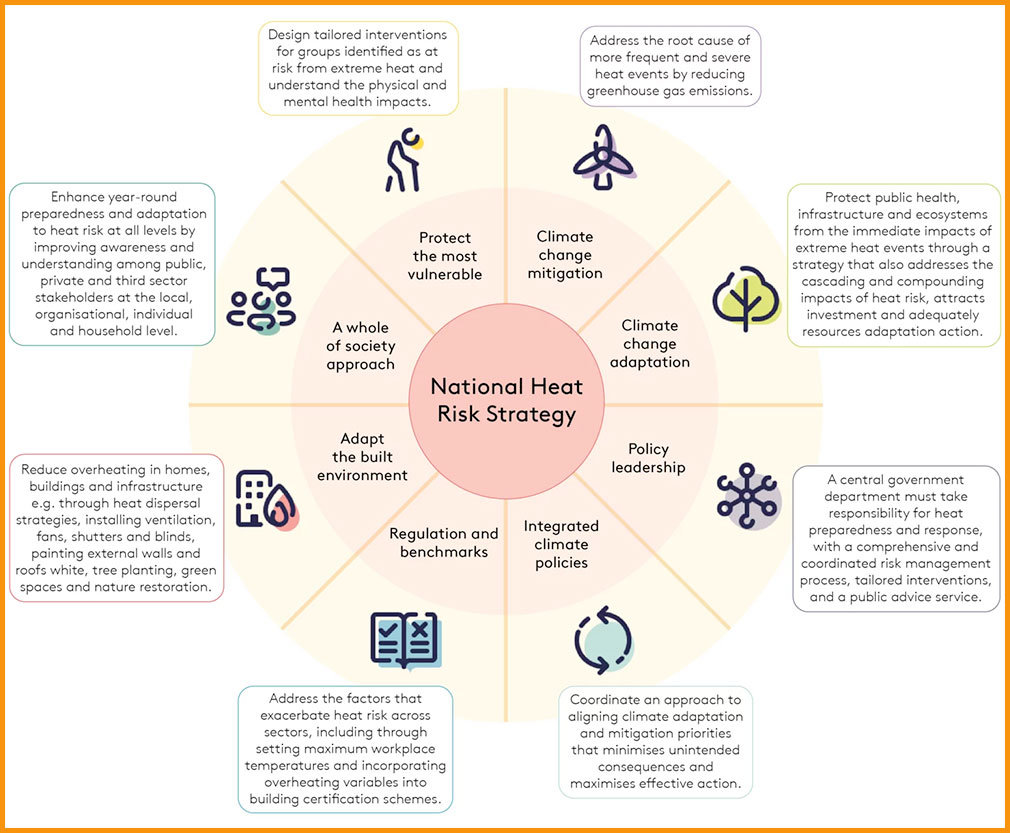Learn from heatwaves to inform UK policy
Turning up the heat: learning from the summer 2022 heatwaves in England to inform UK policy on extreme heat
The UK experienced five heatwave periods during summer 2022 with record-breaking temperatures of over 40°C in England. This was not an anomaly, but part of a warming trend: extreme heat events are projected to become more likely as the climate continues to change.
This evidence report, research drawing from the experiences of those working on the frontline of the heatwave response in England in summer 2022 – including policymakers, emergency responders, utility sector and civil society participants – finds that the country is ill-prepared for future extreme heat events.
To inform future preparedness and responses to extreme heat in the UK, this evidence report evaluates the current policy response to extreme heat, shares lessons from the experiences of decision-makers and first responders to the 2022 heatwaves and recommends that the Government develops a new Heat Risk Strategy (see figure below).
Key messages
- The 2022 heatwaves were associated with a total of 2,985 excess deaths in England and heat exposure is estimated to cost the UK economy £260–300 million per year. Heat poses particular risk for those with pre-existing health conditions and exacerbates existing social and economic inequalities. There are also differences in regional heat vulnerabilities and exposure.
- Better management of heat risk and adaptation action is essential to protect the population and infrastructure. Although the most effective way to minimise the longer-term impacts of extreme heat is through cuts in greenhouse gas emissions, the severity and frequency of heatwave periods will continue to grow even once global emissions reach net zero.
- Reflecting on the 2022 heatwave response in England as a whole and in London, Manchester and Yorkshire and Humber, our research participants expressed a range of concerns, including a lack of preparedness for the heat, a lack of specific resources and funding, and the need for better communication, public engagement and education.
- Positive aspects of the response highlighted by participants were the presence of strong teams, agile decision-making, prioritising vulnerable groups, successful forecasting and early warning systems and the deployment of the national heat alert system.
- Existing policies related to managing extreme heat in England are fragmented and do not adequately address the severity or urgency of heat risk. For example, the Third National Adaptation Programme recognises the risks to human health from extreme heat but fails to offer actions of sufficient scale and urgency to significantly improve heat preparedness.
Over half of UK homes are at risk of overheating: buildings in the UK have been designed to protect from the cold rather than the heat. Building regulations now address overheating risk in new-build homes, but existing homes and buildings are excluded.
- Limited progress has been made to address the risks of heat, drought and wildfires in the natural environment – and to harness the opportunities of nature-based solutions such as green and blue infrastructure to provide cooling urban areas.
- The severity of extreme heat risks and impacts are often underestimated by the UK population and positive media coverage of heatwaves tends to undermine the severity of risks.
- The UK needs a National Heat Risk Strategy, a strengthened National Adaptation Programme and a new vision for leadership to ensure a step change in progress on addressing heat risk at all geographical levels.
A National Heat Risk Strategy for the UK

Source: London School of Economics









Leave a Reply
Want to join the discussion?Feel free to contribute!